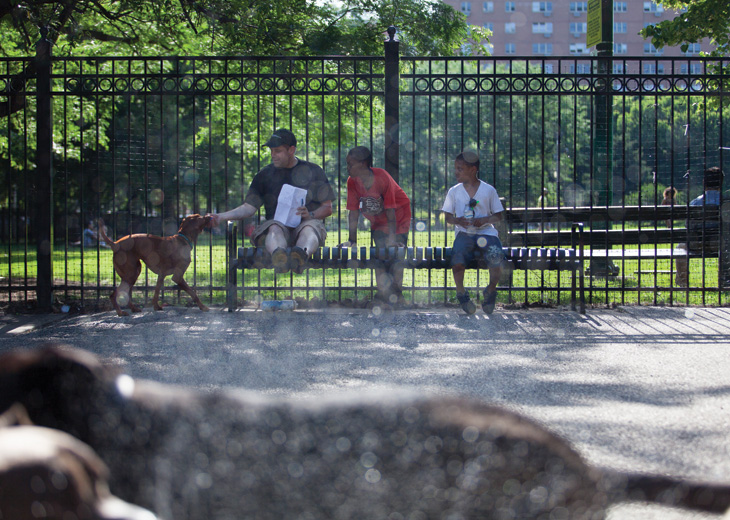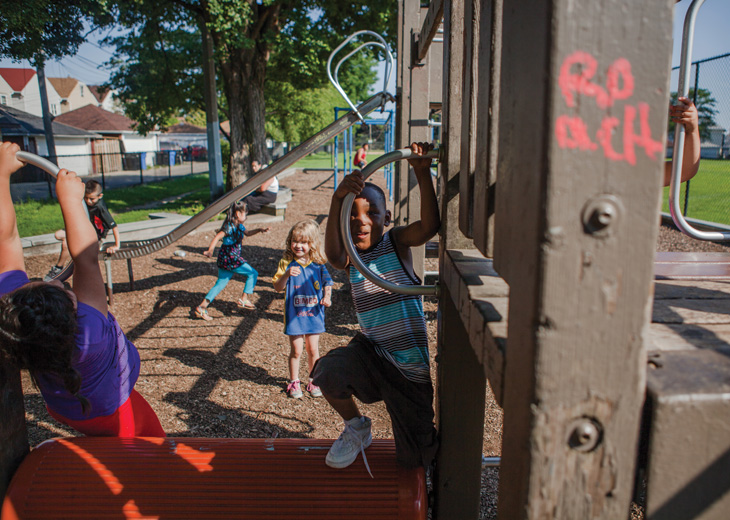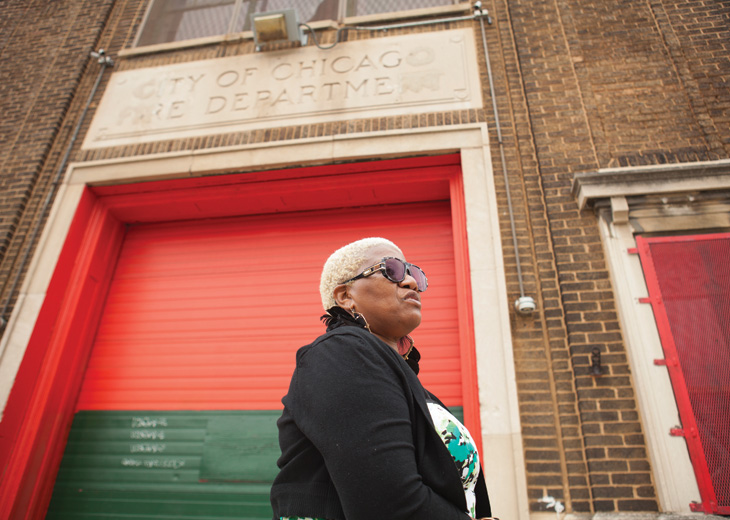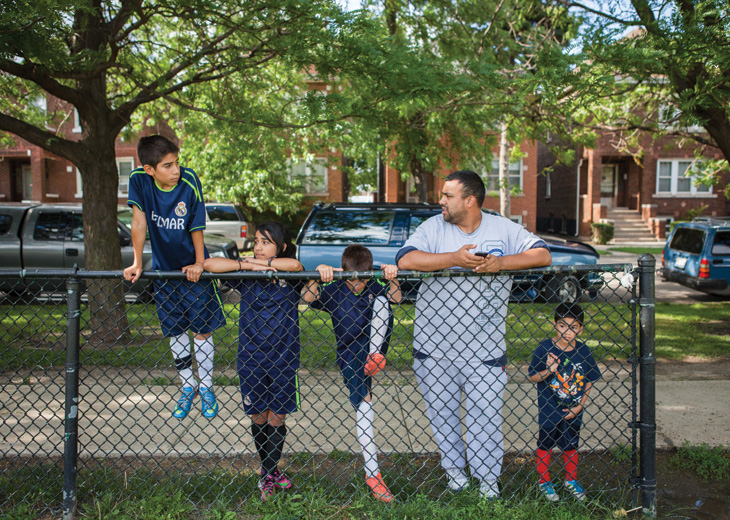In 1983, Wicker Park, a 4-acre triangular space along North Damen Avenue, had none of the amenities that draw people to it today—the field house, the garden club, the dog park. That year, the Chicago Park District signed an agreement with the U.S. Justice Department promising to spread park dollars more equitably around the city. The federal government had sued the district for lavishing its money on parks in predominantly white areas at the expense of those in mostly African-American and Latino communities.
Before the consent decree, the park, which sat at the center of the then working-class Latino neighborhood, wasn’t getting its fair share. After the consent decree, the park got a new field house.
Six years later, federal officials ended the decree, satisfied with the city’s progress. Now, Park District budgets show that race no longer defines whether a park will have staff or programs. Parks in African-American wards now have more money for staff and maintenance than white ones.
That’s just another example of how the decree was a “tremendous success,” says Erma Tranter, the former president of the watchdog group Friends of the Parks who was a champion of equal spending in local parks years before the Justice Department intervened.
Today, the color that determines who gets the most expensive upgrades isn’t primarily black, white or brown; it’s green. More than half of the $500 million spent on Park District improvements since 2011, the year Mayor Rahm Emanuel was elected, went to just 10 of the city’s 77 neighborhoods—seven of them are increasingly white, affluent and have access to outside money.
Critics say parks, one of the most basic city services, have been hijacked by a pay-to-play system. Like other city projects, park improvements rely increasingly on outside grants, city capital money that’s divvied up by aldermen and tax increment financing districts, better known as TIFs. Tax dollars generated from improvements in the districts are plowed back into the same areas rather than included in the city’s general coffers. Though they were created to fuel redevelopment in marginal communities, these special taxing districts can be found in thriving areas like the Loop.
If a neighborhood doesn’t have outside funds, it’s more difficult to acquire new land and amenities, like a field house. A handful of Latino communities are suffering the most as the population continues to grow at a faster pace than park expansion. Four out of the five Latino neighborhoods identified as “parks poor” by The Trust for Public Land, a San Francisco-based organization that advocates for open land, were near the bottom of the list of capital investments in recent years, Park District records show.
The Chicago Park District has made huge strides in spreading programs and facility improvements more evenly along racial lines compared with three decades ago. But when it comes to equity, there are still clear winners and losers.
More than half of the $500 million spent on capital improvements since 2011 went to just a fraction of the city’s neighborhoods, many of which are increasingly wealthy and white. And a disproportionate number of Latino areas are getting the short shrift when it comes to park spending.
Sources and methodology: The Chicago Reporter analyzed the Chicago Park District’s 2014 budget and appropriations report (operations spending is for 2012, the most current year the information was publicly available), capital spending data from 2011 to the present and 2014 summer youth program enrollment data. Population data were gleaned through an analysis of U.S. Census Bureau decennial data.
Gentrifying neighborhoods such as Wicker Park, Logan Square and Lincoln Square, growing hipster havens and areas where Latino families have been rapidly priced out, are among those that have received the bulk of the spending. At the same time, growing working-class Latino communities like Belmont Cragin, Chicago Lawn and Gage Park have become parks poor.
The calculation is based on the number of children who live in a neighborhood and whether they, and their families, can walk to a park, garden or open space within 10 minutes. Some of the city’s densest neighborhoods have the least amount of open space.
“We talk really seriously about the desire to have a 10-minute walk to open space. We’re dedicated to that,” says Rob Rejman, the Chicago Park District’s director of planning.
Rejman says district officials know that there are neighborhoods disproportionately affected by the shortage. The challenge, he says, is: “In these truly parks-poor areas, there is no way for me to spend money because there are no parks.”
“What do I need to do to spend more money there?” he adds. “I need to acquire more parks.”
Acquisition takes long-range planning, which he says is driven by geography and density, not race.
Communities with fewer parks and field houses tend to receive less for programs and facilities. That’s particularly true in Latino wards, which have one-third fewer parks with tennis courts, baseball diamonds, dog parks and playgrounds as white ones. City officials have taken steps to close the gap. Over the past three years, $19 million was channeled into acquiring new park land in Little Village, for example, which removed the neighborhood from The Trust for Public Land’s parks-poor list.
To ensure equity, Michael Pagano, an urban planning and public affairs professor at the University of Illinois at Chicago, says the park system needs to set a baseline—either a dollar amount or in programs, facilities or open space—for services that every community receives. “For services above minimum threshold, I would say, if they are taxing themselves, fine,” he says. “If they are using collective resources and not funding other parks [in need], then it’s wrong.”

Wicker Park got its first improvements under a federal consent decree signed in 1983. However, many of the additional improvements—including a dog park and its renowned gardens—came years later as a result of community activism. [Photo by Michelle Kanaar]
Today, the Brighton Park neighborhood is a lot like Wicker Park was in the 1980s. Most residents are working class; eight out of 10 are Latino. And the push for the same sort of basic park services—a better field house, improved athletic fields, new playgrounds, youth programs—echo the concerns found on the Northwest Side three decades ago. The neighborhood went from a shrinking community of aging Polish and Lithuanian people in the 1980s to a crowded area of Latino families. For years, students at Thomas Kelly High School, which sits at the center of the neighborhood, have attended classes in shifts. The hulking red building is not large enough to accommodate the 2,800 students enrolled. The largest local grammar school was teetering as well. Trailers had to be set up in the schoolyard to meet the students’ needs until a new middle school opened its doors last year to relieve overcrowding.
Across the street from the high school is Kelly Park, a 7-acre plot with uneven sod and a baseball diamond. There’s a playground that’s so old people push their kids on the same swings they used growing up. The field house is slightly larger than a doublewide trailer. It has two bathrooms, an office and an entryway that doubles as a community meeting room.
Aside from a small playground and basketball court tucked in the northwest corner of Brighton Park, Kelly Park is the only park in the neighborhood of 45,000 people. It’s also the only green space near the high school campus. “You would think with the changing population, the city would invest in this,” says Sara Reschly, president of the Kelly Park Advisory Council, as she steps around water and mud that have pooled ankle-deep across the field from a rainstorm the night before.
Instead, the Chicago Park District downgraded the park’s funding last year, which saved money on staffing despite the fact that local spending—at $2.79 per person—is at the bottom compared with every other community in the city, a Chicago Reporter analysis of the Park District’s operating budget found. The median was $21 citywide in 2012, the most recent year for which complete financial data were available.
People from the neighborhood have coped with being parks poor. Teenagers run drills up the stairwell at Kelly High School. Children block off alleys with trash cans so they can play soccer uninterrupted. The Brighton Park Neighborhood Council, where Reschly is the director of community partnerships, is shutting down neighborhood streets for a few hours a week this summer so children have a safe place to play.

As far as Reschly’s concerned, all of those should be short-term solutions. “What we need is more parks and a bigger field house,” she says.
Since 2011, less than 1 percent of all the money spent on park improvements has gone to Kelly Park. Between a local state official and some private foundations, community members cobbled together $400,000 to revamp the field. The Park District and Chicago Public Schools are covering $1 million more this year for a new playground, turf field and baseball diamond.
“We’ve had to fight so hard,” Reschly says of the improvements, which she thinks don’t go far enough.
The advisory council has met with Chicago Park District officials and Ald. George Cardenas (12th) for years, pushing for better facilities to hold more youth programs. Park District enrollment data show the need is there. Thirty percent of the city’s youth population lives in a Latino ward, yet only 17 percent of full-time day camp slots were available at parks in those areas. In contrast, children in white wards had more than a quarter of all day camp slots to choose from but make up less than 10 percent of the city’s youth population.
No one has put a price on expanding the field house, but it would surely cost millions, which Reschly doesn’t think the Park District will seriously consider until community members come up with even more outside funding. The current field renovations are only half of what was recommended by the advisory council.
“The problem is that the formula is one-third comes from the Park District, one-third comes from the alderman or the state and one-third from the community,” she says. “That works well in communities that have money. But in Brighton Park, $1 million is hard to come by.”

Tevell Clayborne, 5, climbs on the decades-old playground equipment at Kelly Park, which is located in the Brighton Park neighborhood, one of the most parks-poor areas in Chicago. The playground is one of 325 scheduled to be replaced within five years. [Photo by Emily Jan]
Across town in West Humboldt Park, Nita Hailey-Gamble has been fighting to renovate Kells Park for years. The park, which stretches across 2 acres at the corner of Chicago and Kedzie avenues, doesn’t have any flowers or a basketball court. The field is unlit and unlocked at night. And there’s no field house. So the Huskies, a local youth football team, chain their practice equipment—spray-painted in the team’s colors of gold and green—to the park fence.
“We have plenty of open space,” says Hailey-Gamble, president of the Kells Park Advisory Council, “but nowhere to store things or run programs.”
She wants the Park District to help the community acquire an abandoned firehouse, which she proposes to convert into a field house.
West Humboldt Park, one of the poorest, most blighted strips of the city, exemplifies the dilemma with parks funding. Park officials are more likely to take a project seriously when there’s matching money on the table, says Ald. Walter Burnett (27th).
Burnett’s 4-mile long ward includes the West Humboldt Park neighborhood but also snakes through some of the city’s wealthiest communities. Most of the park improvements in the ward in recent years, including a new field house on the Near North Side and a dog park just west of the Loop, have occurred in the wealthier sections, which are surrounded by special taxing districts. Burnett tapped the districts’ funds to help finance the upgrades.
Kells is one of 14 parks in Humboldt Park that doesn’t have a field house, a necessary amenity to receive money from the district for programming and staffing. The three staffed parks in the community have a combined budget of $283,000 this year. In per capita spending, the area, like Brighton Park, is among the most parks poor in Chicago. In 2012, the district spent $5.21 per person, $16 shy of the citywide median.
The advisory council holds bake sales and goes door-to-door to raise money for activities like Easter egg hunts, dance parties, movies in the park and neighborhood picnics.
Hailey-Gamble can’t bake or sell enough cakes to raise the seed money for upgrades.
If the firehouse nearby were converted into a field house, staff could run after-school activities and summer camps, and coordinate community events. Without a field house, the only budget is for routine maintenance like cutting the grass.

Nita Hailey-Gamble, president of Kells Park Advisory Council, wants the abandoned firehouse next door to the park to be converted into a field house. [Photo by Michelle Kanaar]
Hailey-Gamble says the park’s condition is just more evidence that city officials “don’t appreciate this area.” The commercial corridor that stretches west of the park along Chicago Avenue is filled with boarded-up buildings. A handful of corner stores and beauty-supply shops coexist with churches.
The 56-year-old was raised in West Humboldt Park, then moved to the suburbs to raise her children. When they grew up, Hailey-Gamble moved back to the neighborhood and threw herself into beautifying it. Kells Park and a community garden are her pet projects.
She sees opportunity in the neighborhood. “The city owns this,” she says of the two-story brick firehouse, which sits on a fenced-off double lot filled with weeds nearly as tall as Hailey-Gamble who’s slightly taller than 5 feet.
“And the bank would probably give this away,” she adds of the two vacant lots next door, which are filled with garbage—chip bags, empty water bottles and candy wrappers. According to the Cook County Assessor’s Office, the properties are valued at $3,000 each.
Rejman says the Park District looked at expanding Kells in 2010 for all of the reasons Hailey-Gamble mentions. “Expansion of existing parks like Kells, we like the idea,” he says.
Initially, the city wanted to hang onto the property because it was being used for storage. Then Park District officials indicated that they might be willing to take the property only if they could knock down the building “To keep acquiring leftover facilities is not financially viable,” Rejman told the Reporter in early July. “Running programs in the park is possible without a field house there.”
After fielding questions from the Reporter and meeting with Hailey-Gamble and the alderman, district officials appear to have had a change of heart. In mid-July, they agreed to acquire the vacant lots next door to the park and lease the firehouse to a community organization, which would have to finance the rehab and any staffing.
Burnett hopes to tap into a nearby TIF district to help pay for the renovations.
“Where there’s a will, you can do anything,” Burnett says. “We’re trying to do something with the park. We’re not waiting for others. We’re creating our destiny.”
Hailey-Gamble says the deal isn’t perfect, but it’s a step in the right direction. “We would have to staff it,” she says. “We’re working on that next.”

Wilson Mendez and his four children wait for their teammates to show up for a soccer match at Kelly Park. Mendez, who has lived in Brighton Park for seven years, coaches one of the local soccer teams. [Photo by Emily Jan]
Park district officials say they can only borrow so much each year to finance improvements, but TIF—or other available money—helps drive projects that are beyond their capital budget. Of the 10 communities that received the most money for capital improvements in recent years, more than $7 of every $10 came from outside of the Park District.
“Outside funds drive a lot of projects,” says Rejman, who acknowledges the strategy has led to an imbalance of new playgrounds and renovations on the North Side. “To even out, we’ve been spending on south and central [regions] from Park District capital funds.” He points to a committment to replace 325 playgrounds over five years as evidence of that.
“The conventional wisdom is that everyone deserves park space,” Pagano says. “The contestation is how much [space] and how much money should be invested [in relation] to other services of the city like public safety, transportation and public health.”
Ald. Rey Colón, whose 35th ward includes Logan Square, says how much is easier to answer when an outside entity helps pay for parks. Most of the parks in his ward aren’t adjacent to a special taxing district. And his “menu money,” the $1.3 million that aldermen divvy up for capital projects each year, is quickly eaten up by repaving alleys and adding lights near El stops.
The area suddenly went from being parks poor to awash in green when the ward received a share of $81 million in federal, state and private money to redevelop a defunct rail line into a bike path. The project, known as the Bloomingdale Trail, stretches from Logan Square to West Town and is being paid for almost exclusively with non-district funds.
The trail, which was recently renamed “The 606,” was conceived more than a decade ago, before the neighborhood was “wealthy or desirable,” he says. Colón, who is a former Park District manager, says the project finally got funded because community members had a plan on paper, and they continued to push it. It also didn’t hurt that more “squeaky wheels,” or residents who aren’t shy about putting pressure on city officials to get things done, have moved to his ward.
Now, Logan Square is quickly outpacing Wicker Park as a hipster destination, and its Latino population is among the fastest-shrinking in the city.
“The ironic thing,” Colón says, “is that you put money into these parks and the community also changes.”


